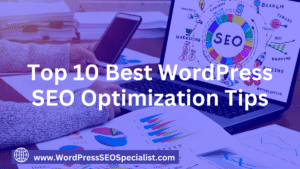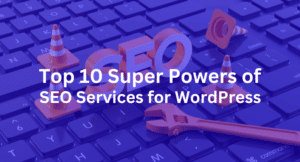Welcome to our comprehensive guide, where we delve deep into the realm of WordPress SEO with over 100 SEO questions curated directly from Google users. In this blog post, we embark on an illuminating journey through the intricacies of optimizing your WordPress website for search engines, answering queries that span from the fundamental to the advanced.
Whether you’re a novice seeking clarity or an experienced practitioner aiming to refine your strategies, this compilation serves as your roadmap to unlocking the full potential of WordPress SEO. Join us as we unravel the mysteries, debunk the myths, and empower you with the knowledge needed to elevate your website’s visibility and drive organic traffic like never before.
Keyword Research:

What are long-tail keywords?
Long-tail keywords are specific and detailed phrases that typically consist of three or more words. Unlike broad or generic keywords, long-tail keywords are more precise and targeted, often reflecting the searcher’s intent more accurately. These phrases cater to niche or specialized topics, allowing websites to attract visitors who are specifically interested in what they offer.
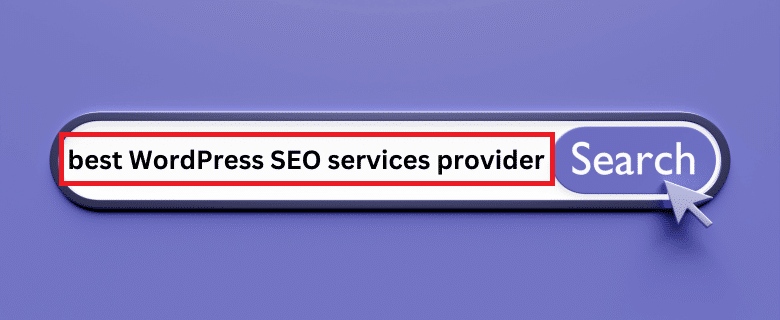
Due to their specificity, long-tail keywords usually have lower search volumes compared to broader terms. However, they often yield higher conversion rates because they match the intent of users more closely, making them a valuable component of SEO strategies.
How do I find long-tail keywords for my WordPress site?
To find long-tail keywords for your WordPress site, start by brainstorming topics related to your niche or industry. Then, use keyword research tools like Google Keyword Planner, SEMrush, or Ubersuggest to identify relevant long-tail keywords with low competition and high search volume. Look for specific phrases or questions that users might type into search engines when looking for information or products related to your site.
Additionally, analyze your competitors’ websites and see what keywords they are targeting. Incorporate these long-tail keywords naturally into your website’s content, including blog posts, product descriptions, and meta tags, to improve your site’s visibility in search engine results and attract targeted traffic. Regularly monitor your keyword performance and adjust your strategy as needed to stay competitive in your industry.
What are keyword research tools?
Keyword research tools are essential instruments used by digital marketers and SEO professionals to identify relevant keywords for optimizing website content. These tools provide valuable insights into search volume, competition, and keyword variations, helping businesses understand their target audience’s search behavior.
These tools often offer features such as keyword suggestion, search volume analysis, keyword difficulty assessment, and competitor analysis. Some popular keyword research tools include Google Keyword Planner, SEMrush, Ahrefs, Moz Keyword Explorer, and Ubersuggest.

Keyword Research Free Tools
By leveraging these tools, businesses can discover high-value keywords that have the potential to drive organic traffic to their websites. This strategic approach to keyword research enables them to create content that resonates with their audience’s search intent, ultimately leading to improved search engine rankings and increased website visibility.
How can I use keyword research to improve my WordPress SEO?
Keyword research is a crucial aspect of improving WordPress SEO. By conducting thorough keyword research, you can identify the most relevant and high-performing keywords related to your niche or industry. These keywords can then be strategically incorporated into your website’s content, including blog posts, product descriptions, and meta tags.
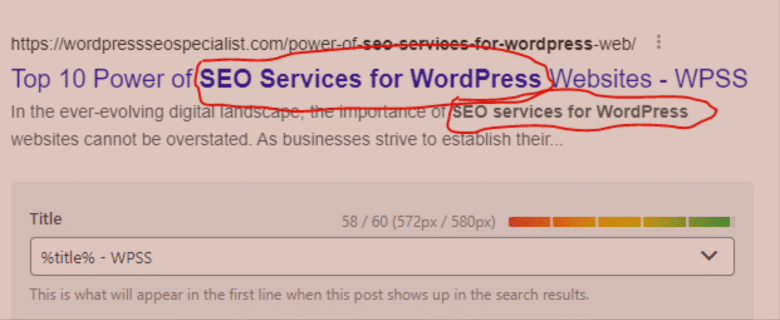
To effectively use keyword research for WordPress SEO, start by using keyword research tools like Google Keyword Planner, SEMrush, or Ahrefs to identify relevant keywords with high search volume and low competition. Next, optimize your content by naturally integrating these keywords into your titles, headings, and body text. Additionally, consider long-tail keywords and semantic keywords to capture more specific search queries.
Regularly monitor and update your keyword strategy based on changes in search trends and user behavior to ensure ongoing optimization of your WordPress SEO efforts.
What is keyword competition?
Keyword competition refers to the level of difficulty or competition associated with ranking for a particular keyword in search engine results pages (SERPs). It indicates how challenging it is to achieve a high ranking for a specific keyword compared to other websites targeting the same keyword. Factors such as the number of websites competing for the keyword, their domain authority, backlink profile, and content relevance contribute to keyword competition.
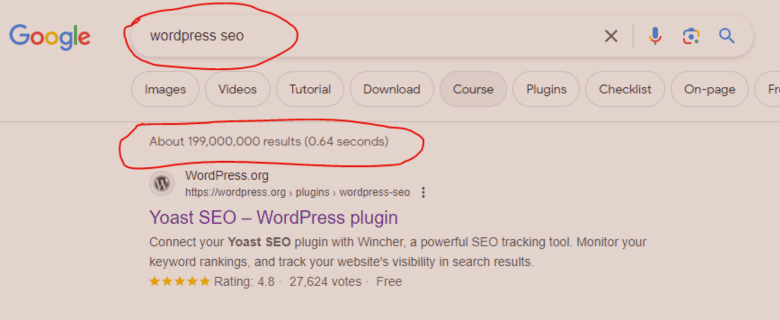
Understanding keyword competition is crucial for SEO strategy as it helps prioritize keywords based on their difficulty level. By targeting keywords with lower competition, businesses can optimize their chances of ranking higher in SERPs and driving organic traffic to their website. Thus, analyzing keyword competition is essential for devising an effective SEO strategy and maximizing online visibility.
How can I find out the competition for a keyword?
To gauge the competition for a keyword, several methods can be employed. One effective approach is to use keyword research tools like SEMrush, Ahrefs, or Google Keyword Planner, which provide valuable insights into keyword competitiveness. These tools typically offer metrics such as keyword difficulty or competition score, indicating the level of competition for a particular keyword.
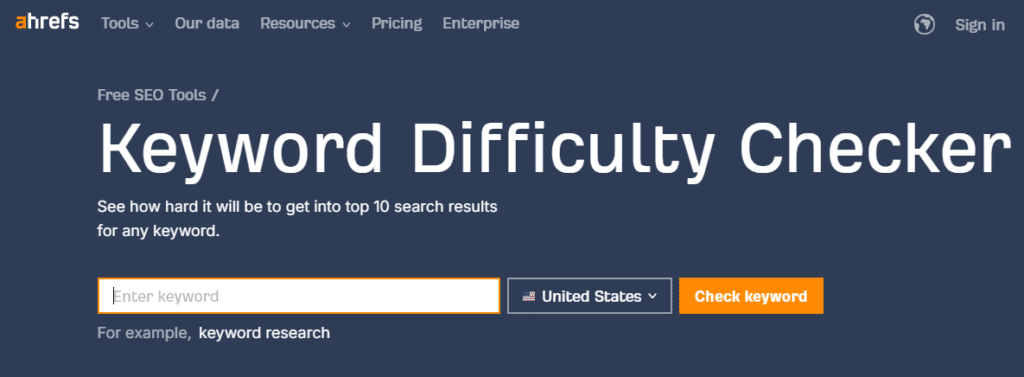
Additionally, conducting a manual search on search engines like Google can also help assess competition by analyzing the number of search results and the quality of the existing content targeting that keyword. By evaluating these factors, you can better understand the level of competition for a keyword and make informed decisions about your SEO strategy and content creation efforts.
Should I target high-competition keywords?
Targeting high-competition keywords can be a double-edged sword in the world of SEO. While these keywords often have high search volumes and the potential for significant traffic, they also come with intense competition from other websites vying for the same keyword rankings.
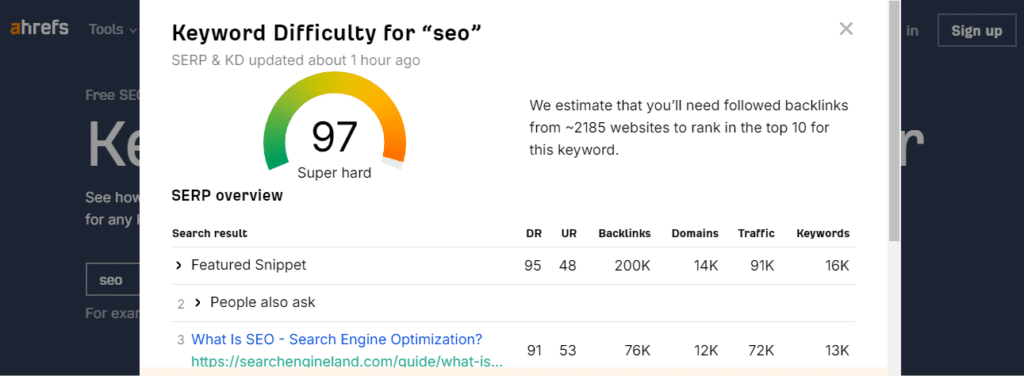
Whether or not you should target high-competition keywords depends on various factors, including your website’s authority, niche, resources, and goals. If you have a well-established website with strong authority and resources to invest in extensive SEO efforts, targeting high-competition keywords may be worthwhile. However, if you’re just starting or have limited resources, it might be more strategic to focus on long-tail or less competitive keywords to build your website’s visibility gradually. Ultimately, it’s essential to weigh the potential benefits against the challenges and make an informed decision based on your specific circumstances and objectives.
On-Page SEO Optimization

What is on-page SEO optimization?
On-page optimization refers to the process of optimizing individual web pages to improve their search engine rankings and attract more organic traffic. It involves optimizing various elements directly on the webpage itself, such as content, HTML source code, and meta tags. Key aspects of on-page optimization include keyword research and optimization, creating high-quality and relevant content, optimizing meta titles and descriptions, improving website loading speed, implementing responsive design for mobile-friendliness, and optimizing internal linking structure.
By focusing on these on-page factors, website owners can enhance their site’s visibility and relevance to search engines, ultimately leading to higher rankings in search results and better user experience for visitors.
How can I optimize my WordPress posts for SEO? 1 What are title tags?
To optimize your WordPress posts for SEO, start by ensuring your content is relevant, valuable, and well-structured. Use keyword research to identify relevant keywords and strategically incorporate them into your post titles, headings, and content. Utilize title tags effectively by crafting descriptive and compelling titles that accurately reflect the content of your posts. Title tags are HTML elements that specify the title of a webpage and are displayed on search engine results pages (SERPs).
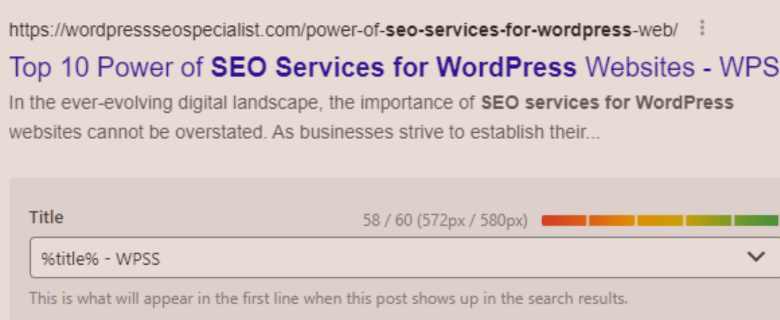
They play a crucial role in SEO as they influence click-through rates and help search engines understand the topic of your content. Additionally, optimize your meta descriptions, use header tags (H1, H2, H3), and include internal and external links to enhance the visibility and ranking of your WordPress posts in search engine results.
How do I write effective title tags for my WordPress posts?
Writing effective title tags for your WordPress posts is crucial for optimizing your content for search engines and attracting clicks from users. Here are some tips to create compelling title tags:
- Be descriptive: Clearly describe the content of your post in the title tag to give users a clear idea of what to expect.
- Use relevant keywords: Incorporate relevant keywords that accurately represent the topic of your post and align with your SEO strategy.
- Keep it concise: Title tags should ideally be between 50-60 characters to ensure they display fully in search engine results.
- Be engaging: Make your title tags compelling and engaging to entice users to click through to your content.
- Include branding: Consider including your brand name in the title tag to increase brand visibility and recognition.
By following these guidelines, you can craft title tags that effectively communicate the content of your WordPress posts and drive traffic to your site.
What are meta descriptions?
Meta descriptions are concise summaries that describe the content of a web page. They appear below the title tag in search engine results pages (SERPs) and provide users with a preview of what they can expect to find on the webpage. Meta descriptions play a crucial role in enticing users to click on a search result by providing relevant information about the page’s content.
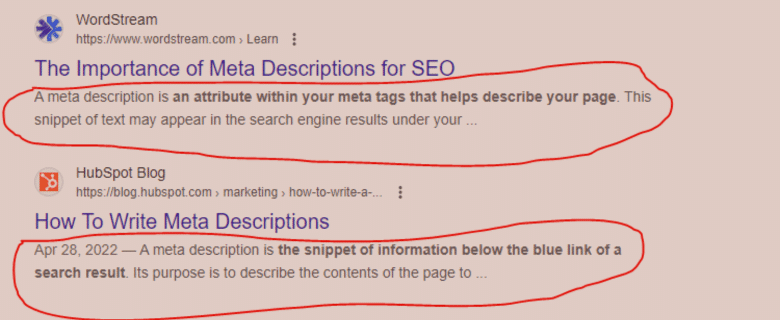
These descriptions should be compelling, informative, and accurately represent the content of the page. While they don’t directly impact search engine rankings, well-crafted meta descriptions can significantly improve click-through rates and drive more traffic to a website. It’s essential to keep meta descriptions concise, typically between 150-160 characters, to ensure they display properly in search results and capture users’ attention effectively.
How do I write compelling meta descriptions for my WordPress posts?
Writing compelling meta descriptions for your WordPress posts is essential for attracting clicks and improving your search engine visibility. To create effective meta descriptions, start by understanding your target audience and what they’re searching for. Craft a concise and engaging description that accurately summarizes the content of your post while also appealing to the reader’s emotions or curiosity. Use action-oriented language and include relevant keywords to increase the likelihood of your post appearing in search results.
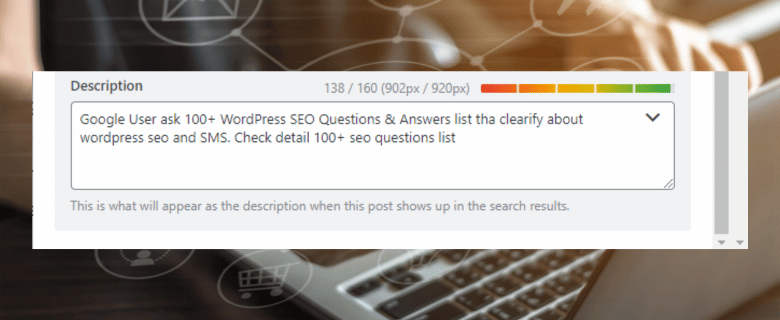
Keep your meta descriptions between 150-160 characters to ensure they display properly on search engine results pages. Finally, test different variations to see which ones resonate best with your audience and lead to higher click-through rates. By following these tips, you can write compelling meta descriptions that drive traffic to your WordPress posts.
What are header tags (H1, H2, H3, etc.)?
Header tags, including H1, H2, H3, etc., are HTML elements used to structure and organize content on webpages. These tags play a crucial role in SEO by providing search engines with context about the content and helping them understand the hierarchy of information on a page.
The H1 tag is typically used for the main heading of the page, signaling its topic to both users and search engines. H2 tags are used for subheadings, followed by H3 tags for subsections within those subheadings, and so on.
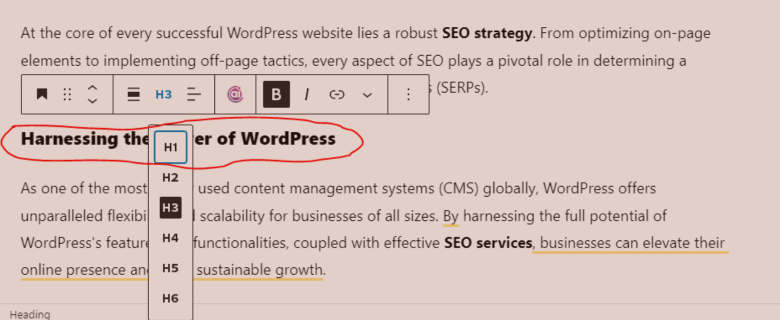
By utilizing header tags effectively, website owners can improve the readability and user experience of their content while also signaling its relevance to search engines. This can ultimately contribute to better search engine rankings and increased visibility for the webpage.
How do I use header tags correctly in my WordPress posts?
Using header tags correctly in WordPress posts is crucial for both SEO and user experience. Here’s how you can do it effectively:
- Hierarchy: Utilize header tags (H1, H2, H3, etc.) to establish a clear hierarchy of your content. The H1 tag should be reserved for the main title of your post, while H2 tags are used for section headings, and so on.
- Organization: Structure your content logically by breaking it into sections with relevant header tags. This helps readers navigate through your content easily and understand the main points at a glance.
- Keyword Optimization: Incorporate relevant keywords into your header tags to improve SEO. However, ensure that the keywords flow naturally within the context of your content and avoid keyword stuffing.
- Consistency: Maintain consistency in your use of header tags throughout your post to maintain coherence and readability.
By following these guidelines, you can effectively use header tags to enhance both the SEO and readability of your WordPress posts.
What is internal linking?
Internal linking is the practice of connecting one page of a website to another page within the same domain. It involves adding hyperlinks from one piece of content to another relevant piece of content on the same website. This strategy helps users navigate your website more easily and also helps search engines understand the structure and hierarchy of your site.
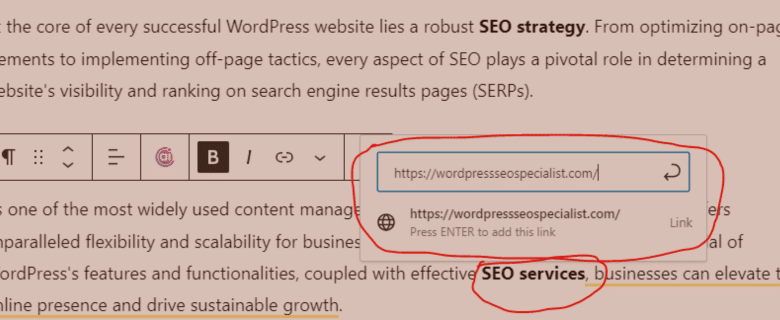
Internal linking can improve the user experience by providing additional information or related content to visitors, encouraging them to explore more pages on your site. From an SEO perspective, it also distributes link equity across your website, which can help improve the rankings of important pages in search engine results. Overall, internal linking is a fundamental aspect of website optimization that enhances both user engagement and search engine visibility.
How can I improve my WordPress internal linking?
Improving internal linking on your WordPress website is essential for enhancing user experience and SEO performance. Start by conducting a thorough audit of your existing content to identify opportunities for linking related pages or posts. Utilize anchor text that accurately describes the linked content and strategically place internal links within your content to guide users to relevant information.
Consider implementing a hierarchical structure for your internal links, prioritizing important pages or posts and ensuring they receive more links. Additionally, use plugins like Yoast SEO or Rank Math to automate internal linking suggestions and streamline the process. Regularly monitor and update internal links as your content evolves to maintain relevance and improve navigation throughout your website. By following these practices, you can enhance the user experience, increase page views, and boost your WordPress site’s overall SEO performance.
What are images and how to optimize them for SEO?
Images play a crucial role in enhancing the visual appeal of a website and engaging visitors. In terms of SEO, optimizing images is essential for improving website performance and search engine rankings. To optimize images for SEO, several key steps can be taken. Firstly, ensure that images are relevant to the content they accompany, as this helps search engines understand the context of the page. Additionally, use descriptive file names and alt text that include relevant keywords to improve accessibility and provide additional context to search engines.
Compressing images to reduce file size without sacrificing quality can also improve website loading speed, which is a key ranking factor. Finally, utilizing image sitemaps can help search engines discover and index images more effectively, further enhancing SEO efforts. Overall, optimizing images for SEO involves a combination of relevance, accessibility, speed, and indexing considerations.
How can I optimize images for SEO in WordPress?
Optimizing images for SEO in WordPress is crucial for improving website performance and user experience. Here’s how you can do it:
- Choose the right file format: Use JPEG for photographs and PNG for graphics with transparency.
- Compress images: Reduce file size without compromising quality using plugins like Smush or ShortPixel.
- Use descriptive filenames: Rename images to include relevant keywords before uploading.
- Add alt text: Write concise and descriptive alt text that accurately describes the image and includes keywords.
- Resize images: Scale images to the appropriate dimensions to reduce load times.
- Utilize image sitemaps: Submit an image sitemap to search engines to help them discover and index your images.
- Enable lazy loading: Load images as users scroll down the page to improve loading speed.
- Implement responsive design: Ensure images adapt to different screen sizes for optimal viewing on all devices.
By following these steps, you can effectively optimize images for SEO in WordPress and enhance your website’s visibility and performance.
What is image alt text?
Image alt text, also known as alt attributes or alt descriptions, is a brief text description added to the HTML code of an image on a website. Its primary purpose is to provide context and information about the image content for users who may not be able to view the image due to accessibility reasons, such as screen readers used by visually impaired individuals or when the image fails to load. Alt text serves as an alternative to visually convey the meaning and purpose of the image to these users.
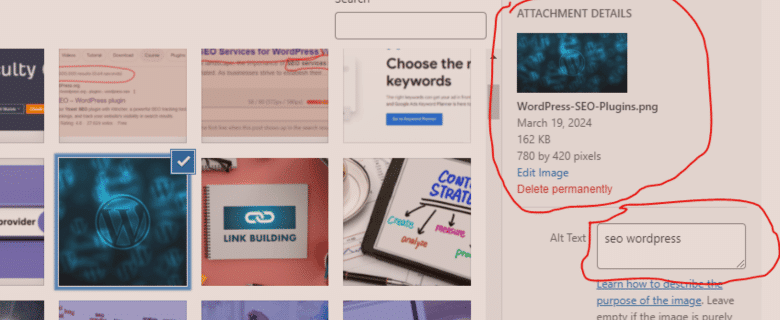
Additionally, search engines utilize alt text to understand the content of images, which can contribute to better indexing and ranking of web pages in search results. Therefore, creating descriptive and relevant alt text is essential for both accessibility and search engine optimization purposes.
How do I write effective image alt text for my WordPress posts?
Writing effective image alt text for your WordPress posts is crucial for improving accessibility and SEO. Here’s how you can do it effectively:
- Be descriptive: Describe the content and purpose of the image accurately in a concise manner.
- Include relevant keywords: Incorporate relevant keywords related to the image and your content to enhance SEO.
- Provide context: Ensure that the alt text provides context for users who cannot view the image, helping them understand its relevance to the content.
- Avoid keyword stuffing: While it’s important to include keywords, avoid overloading the alt text with too many keywords, as it can appear spammy.
- Keep it concise: Aim for a balance between descriptive and concise. Ideally, alt text should be around 125 characters or less.
By following these guidelines, you can write effective image alt text that improves accessibility and boosts SEO for your WordPress posts.
Technical SEO:

What is technical SEO?
Technical SEO refers to the optimization of your website’s technical aspects to improve its search engine visibility and user experience. It involves optimizing factors such as website speed, mobile-friendliness, crawlability, site architecture, and indexing. By focusing on technical SEO, you ensure that search engines can effectively crawl and index your website, leading to better rankings in search results.
Technical SEO also includes tasks like fixing broken links, optimizing robots.txt files, creating XML sitemaps, implementing schema markup, and improving website security with HTTPS. Overall, technical SEO lays the foundation for your website’s success by ensuring it is accessible, fast, and user-friendly for both search engines and visitors. It’s an essential aspect of SEO that complements other optimization efforts and helps maximize your website’s potential for organic traffic and conversions.
How can I improve the technical SEO of my WordPress site?
Improving the technical SEO of your WordPress site involves optimizing various technical aspects to enhance its search engine visibility and user experience. Firstly, ensure your site has a clean and efficient code structure, as search engines favor fast-loading and well-structured websites. Utilize SEO-friendly themes and plugins, focusing on mobile responsiveness and schema markup implementation. Additionally, optimize site speed by minimizing CSS and JavaScript files, leveraging browser caching, and optimizing images.
Implement HTTPS protocol for secure browsing and ensure proper URL structure, canonical tags, and XML sitemap generation. Regularly audit your site for crawl errors, broken links, and duplicate content using tools like Google Search Console and Screaming Frog. Lastly, prioritize user experience by improving navigation, fixing 404 errors, and enhancing internal linking. By addressing these technical aspects, you can significantly boost your WordPress site’s SEO performance and user satisfaction
What is a website sitemap?
A website sitemap is a file that lists all the pages of a website, helping search engines understand its structure and hierarchy. It serves as a roadmap for search engine crawlers, guiding them to discover and index all the pages on the site efficiently. In WordPress SEO, having a well-organized sitemap is crucial for ensuring that all your website’s content is properly indexed by search engines, which can improve your site’s visibility in search results.

WordPress plugins like Yoast SEO and Rank Math automatically generate XML sitemaps, making it easy for website owners to submit them to search engines like Google. By including all your site’s URLs in the sitemap, you can enhance your WordPress SEO efforts and increase the chances of your content being ranked higher in search engine results pages (SERPs).
How do I create a sitemap for my WordPress site?
Creating a sitemap for your WordPress site is essential for effective SEO. Fortunately, WordPress makes this process straightforward. You can use plugins like Yoast SEO, Rank Math or Google XML Sitemaps to generate and manage your sitemap automatically. After installing the plugin, navigate to its settings and enable the sitemap feature. Once activated, the plugin will generate a sitemap.xml file that includes all your website’s pages, posts, and other content.
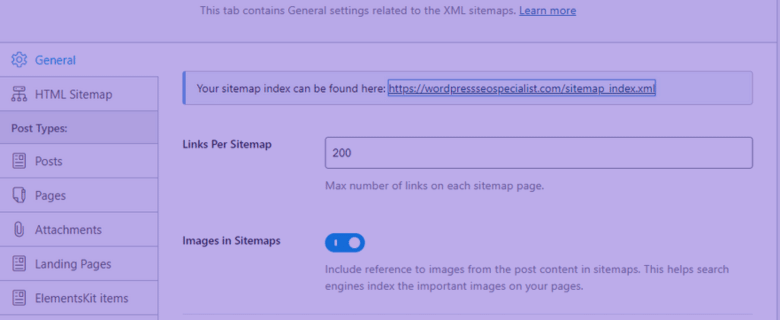
This XML file acts as a roadmap for search engine crawlers, helping them discover and index your site’s pages more efficiently. Additionally, regularly updating your sitemap ensures that search engines are aware of any new content or changes on your site, further improving your WordPress SEO efforts.
What is robots.txt?
Robots.txt is a text file located in the root directory of a website that instructs search engine crawlers on which pages to crawl or avoid. In the context of WordPress SEO, understanding robots.txt is crucial for controlling the indexing of website content and directing search engine bots to prioritize crawling important pages for SEO purposes.
By specifying which pages should be crawled and which should be excluded, website owners can optimize their WordPress sites for better search engine visibility and rankings. Proper management of robots.txt ensures that search engines focus on indexing relevant content, enhancing the overall SEO performance of WordPress websites. It’s essential to regularly review and update the robots.txt file to align with SEO strategies and ensure optimal crawling and indexing of website content.
How do I edit the robots.txt file for my WordPress site?
To edit the robots.txt file for your WordPress site, follow these steps. First, access your WordPress dashboard and navigate to the “Settings” tab. From there, click on “Reading” and scroll down to find the “Search Engine Visibility” option. Uncheck the box labeled “Discourage search engines from indexing this site.” This action ensures that search engines can crawl your site and index its content.
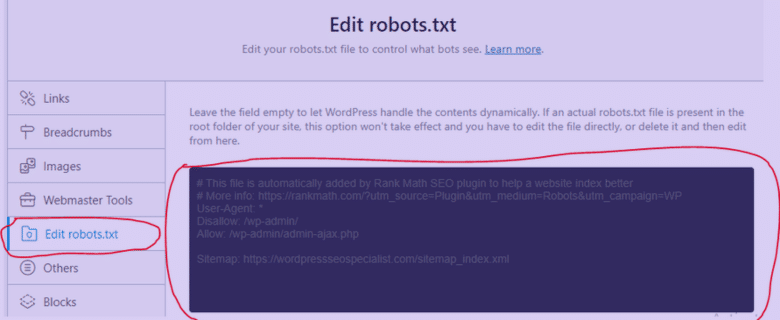
Next, install a WordPress SEO plugin like Yoast SEO or Rank Math, which provides options to edit the robots.txt file directly within the plugin settings. Alternatively, you can use an FTP client to access your site’s root directory and locate the robots.txt file. Open the file using a text editor and make the necessary modifications to control search engine crawling and indexing on your WordPress site. Ensure to save the changes and test the robots.txt file using Google’s robots.txt tester tool to confirm proper functionality.
What is mobile-friendliness?
Mobile-friendliness refers to the responsiveness and usability of a website on mobile devices such as smartphones and tablets. In the context of WordPress SEO, mobile-friendliness is crucial because search engines prioritize mobile-friendly websites in their rankings. With the increasing number of users accessing the internet via mobile devices, having a mobile-friendly website is essential for providing a seamless user experience and improving search engine rankings.
WordPress websites can enhance mobile-friendliness by using responsive design themes, optimizing images and media for mobile viewing, and ensuring fast loading times. Additionally, implementing mobile-friendly features such as easy navigation and clickable buttons can further enhance the user experience, leading to higher engagement and better SEO performance.
How can I make my WordPress site mobile-friendly?
Making your WordPress site mobile-friendly is crucial for enhancing user experience and improving SEO rankings. To achieve this, you can use responsive themes that automatically adjust to different screen sizes, ensuring seamless navigation on mobile devices. Additionally, optimize images and videos for mobile viewing, minimize the use of large files that can slow down loading times, and prioritize mobile-friendly plugins.
Implementing a mobile-friendly design not only caters to the growing number of mobile users but also aligns with Google’s mobile-first indexing, which prioritizes mobile-optimized websites in search results. By focusing on mobile-friendliness, you enhance user satisfaction, reduce bounce rates, and ultimately boost your WordPress SEO performance.
What is page speed?
Page speed refers to the time it takes for a web page to load fully in a user’s browser. In the realm of WordPress SEO, page speed plays a crucial role in determining a website’s ranking on search engine results pages (SERPs). Search engines like Google prioritize websites with faster loading times, as they offer a better user experience.
Optimizing page speed involves various strategies, such as minimizing server response time, optimizing images, leveraging browser caching, and reducing unnecessary plugins and scripts. By improving page speed, WordPress websites can enhance user engagement, reduce bounce rates, and ultimately improve their SEO performance.
Therefore, prioritizing page speed optimization as part of your WordPress SEO strategy is essential for maximizing your website’s visibility and attracting more organic traffic.
How can I improve the page speed of my WordPress site?
Improving the page speed of your WordPress site is crucial for enhancing user experience and SEO performance. To optimize your site’s speed, start by optimizing images and minimizing HTTP requests. Utilize caching plugins and leverage browser caching to reduce load times. Additionally, choose a reliable hosting provider and consider using a content delivery network (CDN) to distribute content more efficiently. Minify CSS, JavaScript, and HTML files to decrease file sizes and enable lazy loading for images and videos.
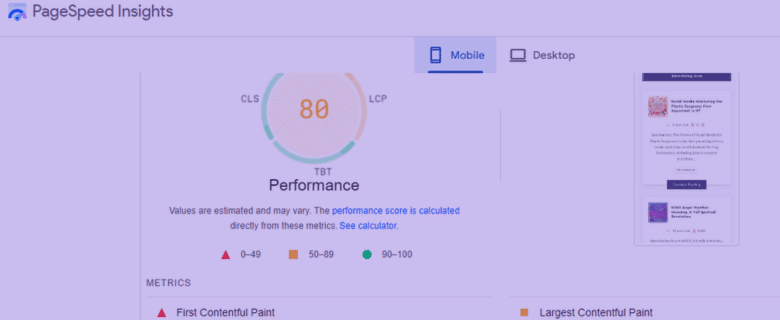
Regularly update WordPress, themes, and plugins to ensure compatibility and performance enhancements. Lastly, use tools like Google PageSpeed Insights to identify performance issues and implement recommended optimizations. By prioritizing page speed optimization, you can enhance user satisfaction and boost your WordPress SEO rankings effectively.
Content Strategy:

What is content strategy?
A content strategy is a crucial aspect of WordPress SEO, outlining the plan for creating, publishing, and managing content to improve website visibility and attract more visitors. It involves identifying target audience interests, conducting keyword research, and developing a structured approach to content creation. By aligning content with SEO best practices and user intent, a well-defined strategy can enhance website rankings and drive organic traffic.
Content strategy also includes setting goals, establishing content formats and schedules, and implementing metrics for tracking performance. Ultimately, it ensures that the content produced is relevant, valuable, and optimized for search engines, contributing to the overall success of WordPress SEO efforts.
How can I create a content strategy for my WordPress site?
Creating a robust content strategy for your WordPress site is crucial for effective WordPress SEO. Start by conducting keyword research to identify relevant topics and long-tail keywords related to your niche. Next, define your target audience and their needs to tailor your content accordingly.
Leverage WordPress plugins like Yoast SEO or Rank Math to optimize your content for search engines by adding meta titles, descriptions, and optimizing headings. Additionally, focus on producing high-quality, valuable content that resonates with your audience and encourages engagement.
Regularly update your content to keep it fresh and relevant, and incorporate multimedia elements like images, videos, and infographics to enhance user experience. Finally, track your content performance using analytics tools to refine your strategy and ensure continuous improvement. By following these steps, you can develop a successful content strategy that boosts your WordPress site’s SEO and drives organic traffic.
What are the different types of content?
The different types of content in the realm of WordPress SEO encompass a wide range of formats and styles tailored to engage and resonate with various audiences. These include blog posts, articles, infographics, videos, podcasts, case studies, whitepapers, eBooks, webinars, and social media posts. Each type serves a unique purpose and appeals to different user preferences and consumption habits.
For instance, blog posts are excellent for providing informative and timely updates, while videos are great for visually showcasing products or demonstrating processes. By diversifying your content strategy and incorporating various formats, you can effectively reach and connect with your target audience, thereby enhancing your WordPress SEO efforts and improving your website’s visibility and rankings in search engine results pages.
How often should I publish new content on my WordPress site?
Publishing new content regularly is crucial for maintaining a strong presence and improving your WordPress SEO. Aim for consistency in your posting schedule, whether it’s once a week, bi-weekly, or even daily, depending on your niche and audience engagement. Regular updates not only signal to search engines that your site is active and relevant but also provide valuable information for your visitors.
Additionally, fresh content gives you more opportunities to target new keywords, attract backlinks, and engage with your audience. Ultimately, the frequency of content publication should align with your resources, goals, and audience preferences. By prioritizing regular updates, you can enhance your WordPress SEO efforts and establish your site as a trusted source in your industry.
What is content marketing?
Content marketing is a strategic approach to creating and distributing valuable, relevant, and consistent content to attract and engage a specific audience. In the context of WordPress SEO, content marketing plays a crucial role in driving organic traffic and improving search engine rankings. By producing high-quality content optimized with relevant keywords and addressing the needs and interests of your target audience, you can enhance your website’s visibility and authority in search results.
Content marketing on WordPress involves creating blog posts, articles, videos, infographics, and other content formats that align with your SEO strategy. It aims to establish your website as a valuable resource in your niche, earning backlinks, and social shares, and ultimately improving your WordPress SEO performance.
How can I use content marketing to improve my WordPress SEO?
Content marketing plays a crucial role in enhancing WordPress SEO by providing valuable, relevant, and engaging content that attracts and retains visitors. To leverage content marketing effectively for WordPress SEO, focus on creating high-quality, keyword-optimized content that aligns with your target audience’s interests and needs. Incorporate relevant keywords naturally throughout your content, including in titles, headings, and body text, to improve visibility in search engine results.
Additionally, regularly publishing fresh and informative content not only keeps your website updated but also encourages search engines to crawl and index your site more frequently, boosting its SEO performance. Furthermore, promoting your content across various channels, such as social media and email newsletters, can drive more traffic to your WordPress site, enhancing its overall SEO impact. By implementing a strategic content marketing strategy, you can significantly improve your WordPress SEO and attract more organic traffic to your website.
Link Building:
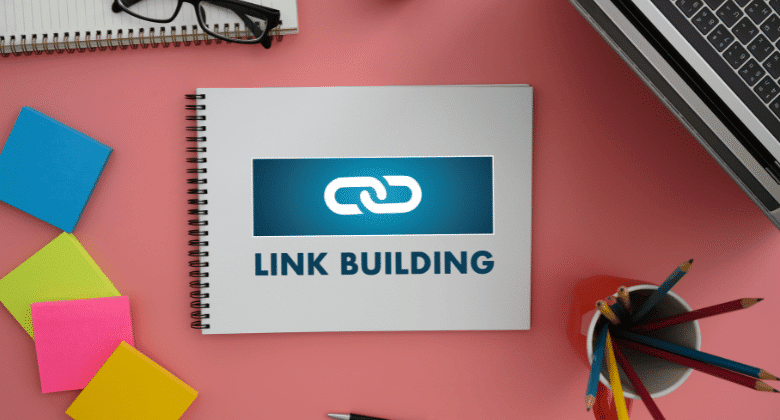
What is link building?
Link building is a crucial aspect of WordPress SEO, referring to the process of acquiring hyperlinks from other websites to your own. These inbound links serve as votes of confidence for your site’s credibility and authority in the eyes of search engines like Google. By obtaining high-quality backlinks from reputable and relevant websites, you can significantly enhance your WordPress site’s search engine rankings and visibility.
However, it’s essential to prioritize quality over quantity when building links, focusing on natural and organic link acquisition methods rather than resorting to spammy or black-hat techniques. Additionally, diversifying your link profile with a mix of different types of links, such as editorial, guest blogging, and directory links, can further strengthen your site’s SEO performance and help you achieve sustainable long-term results.
Why is link-building important for SEO?
Link-building is crucial for WordPress SEO because it helps to establish your website’s authority and credibility in the eyes of search engines like Google. When other reputable websites link back to your content, it signals to search engines that your site is trustworthy and valuable to users. This can lead to higher rankings in search results, increased organic traffic, and ultimately, more visibility for your WordPress website.
Additionally, quality backlinks from relevant and authoritative sources can also drive direct referral traffic to your site, expanding your audience and potential customer base. By strategically building links through guest posting, content outreach, and other methods, you can improve your WordPress SEO efforts and position your site for long-term success in the competitive online landscape.
How can I build backlinks to my WordPress site?
Building backlinks to your WordPress site is crucial for improving its SEO performance and increasing visibility on search engine results pages. One effective strategy is to create high-quality, relevant content that naturally attracts backlinks from other websites. You can also reach out to relevant websites and blogs in your industry to request backlinks or guest posting opportunities.
Additionally, participating in online communities, such as forums or social media groups, and sharing your content can help generate backlinks. Leveraging influencer partnerships and collaborating on content with other websites can also be beneficial. Remember to focus on creating valuable and shareable content that resonates with your target audience to attract organic backlinks and enhance your WordPress SEO.
What is guest blogging?
Guest blogging is a strategic approach to content marketing wherein an individual contributes a blog post to another website or blog in the same industry or niche. From a WordPress SEO perspective, guest blogging serves as an effective means to build backlinks to your website, thereby enhancing its authority and credibility in the eyes of search engines like Google.
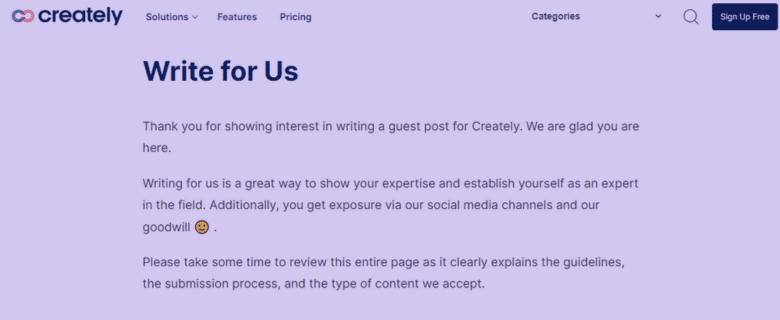
By publishing high-quality guest posts on reputable websites, you not only gain exposure to a wider audience but also attract valuable inbound links that signal to search engines the relevance and authority of your WordPress site. This contributes to improved search engine rankings and increased organic traffic over time. Additionally, guest blogging fosters networking opportunities and allows you to establish yourself as an industry expert, further boosting your WordPress SEO efforts.
How can I use guest blogging to build backlinks?
Guest blogging is a powerful strategy for building backlinks and enhancing your WordPress SEO. By contributing high-quality content to reputable websites within your niche, you can earn valuable backlinks to your own site. When guest blogging, it’s essential to focus on relevance and authority, ensuring that the websites you collaborate with are credible and aligned with your industry or niche. Additionally, optimize your guest posts with relevant keywords and include a link back to your WordPress site within the content or author bio.
By consistently guest blogging on authoritative platforms, you can increase your site’s visibility, drive more traffic, and improve your overall SEO performance. Remember to prioritize quality over quantity and maintain a strategic approach to guest blogging for optimal results in boosting your WordPress SEO.
What are broken links?
Broken links are hyperlinks on a website that no longer lead to their intended destination. They often result in error messages such as “404 Not Found” when clicked. In the context of WordPress SEO, broken links can negatively impact a website’s search engine rankings and user experience. Search engines like Google consider broken links as a signal of poor website quality, leading to lower credibility and authority. Additionally, broken links can frustrate visitors, causing them to leave the site prematurely, which can increase bounce rates and decrease overall engagement.
Therefore, it’s essential for WordPress website owners to regularly monitor and fix broken links to maintain a positive user experience and improve SEO performance. Using tools like Google Search Console or WordPress plugins can help identify and address broken links efficiently.
How can I fix broken links on my WordPress site?
Fixing broken links on your WordPress site is crucial for maintaining a positive user experience and improving your WordPress SEO. To address this issue, you can utilize various tools and techniques. Firstly, identify broken links using online link checkers or WordPress plugins specifically designed for this purpose. Once identified, you can either update the URL of the broken link or remove it entirely from your content.
Additionally, consider implementing 301 redirects for broken links to ensure seamless navigation for users and preserve your website’s SEO value. Regularly monitoring and fixing broken links not only enhances user satisfaction but also contributes to better search engine rankings, as search engines favor websites with clean and functional link structures.
WordPress SEO Plugins

What are WordPress SEO plugins?
WordPress SEO plugins are essential tools for optimizing your WordPress website to improve its search engine ranking and visibility. These plugins offer a range of features and functionalities designed to enhance various aspects of SEO, such as keyword optimization, meta tags management, XML sitemap generation, and more. Popular WordPress SEO plugins like Yoast SEO, Rank Math, and All in One SEO Pack provide user-friendly interfaces and customizable settings to help you optimize your site’s content effectively.
By leveraging these plugins, you can streamline your SEO efforts, identify areas for improvement, and implement best practices to boost your site’s performance on search engine results pages. Overall, WordPress SEO plugins are indispensable tools for website owners looking to enhance their online presence and attract more organic traffic to their sites.
What are the best WordPress SEO plugins?
When it comes to enhancing the SEO performance of your WordPress website, choosing the right plugins can make a significant difference. Among the plethora of options available, some of the best WordPress SEO plugins include Yoast SEO, Rank Math, and All in One SEO Pack. These plugins offer a range of features to optimize your website for search engines, such as XML sitemap generation, meta tag optimization, and content analysis. Yoast SEO, for example, provides valuable insights into keyword optimization and readability, helping you create SEO-friendly content.
Rank Math offers advanced features like schema markup integration and advanced SEO analysis, while All in One SEO Pack is known for its simplicity and ease of use. Ultimately, the best WordPress SEO plugin for you will depend on your specific needs and preferences, but any of these options can be a valuable addition to your SEO toolkit.
How do I use a WordPress SEO plugin to improve my SEO?
To enhance your SEO using a WordPress SEO plugin, start by installing a reputable plugin like Yoast SEO or Rank Math. These plugins offer comprehensive features to optimize your website for search engines. Begin by configuring the plugin settings, including title tags, meta descriptions, and XML sitemaps. Utilize the plugin’s on-page analysis tool to optimize individual posts and pages for target keywords, ensuring proper keyword density and readability.
Additionally, leverage features like schema markup, internal linking suggestions, and social media integration offered by the plugin to further enhance your SEO efforts. Regularly monitor the plugin’s insights and recommendations to identify areas for improvement and track your SEO progress over time. By implementing these strategies, you can effectively utilize a WordPress SEO plugin to elevate your website’s search engine rankings and drive organic traffic.
Is Yoast SEO a good plugin?
Yes, Yoast SEO is widely regarded as one of the best plugins for WordPress SEO. It offers a comprehensive suite of features designed to optimize your website’s on-page SEO elements, such as meta titles, meta descriptions, and keyword density. With Yoast, you can easily analyze your content’s readability and SEO score, making it easier to identify areas for improvement.
Additionally, Yoast provides valuable insights into your website’s overall SEO health, including XML sitemap generation and social media integration. Its user-friendly interface and robust functionality make it a favorite among WordPress users, both beginners and experts alike. Overall, Yoast SEO is a powerful tool that can significantly enhance your WordPress website’s SEO performance and help you climb the search engine rankings.
Is Rank Math a good plugin?
Yes, Rank Math is an excellent plugin for WordPress SEO. It offers a comprehensive set of features designed to optimize your website’s search engine performance. With its user-friendly interface and powerful capabilities, Rank Math makes it easy for website owners to implement essential SEO strategies. From optimizing meta tags and generating XML sitemaps to monitoring keyword rankings and analyzing on-page SEO, Rank Math covers all aspects of WordPress SEO.
Additionally, it provides helpful insights and recommendations to improve your site’s SEO performance further. Overall, Rank Math is a highly recommended plugin for anyone looking to enhance their WordPress website’s visibility and attract more organic traffic.
SEO Analytics:

What are SEO analytics?
SEO analytics refers to the process of analyzing data and metrics related to search engine optimization efforts. In the context of WordPress SEO, it involves tracking and evaluating various aspects of your website’s performance in search engine results pages (SERPs). This includes monitoring keyword rankings, organic traffic, click-through rates, bounce rates, and conversion rates. By leveraging SEO analytics tools such as Google Analytics and WordPress plugins like Yoast SEO or Rank Math, website owners can gain valuable insights into their SEO strategies’ effectiveness.
These analytics help identify areas for improvement, track progress over time, and make data-driven decisions to optimize WordPress websites for better search engine visibility and higher rankings. Ultimately, SEO analytics play a crucial role in enhancing WordPress SEO efforts and driving meaningful results for online businesses.
How can I track my WordPress SEO performance?
Tracking your WordPress SEO performance is crucial for assessing the effectiveness of your optimization efforts. To do so, you can utilize various tools and metrics tailored specifically for WordPress websites. One effective method is to leverage WordPress SEO plugins like Yoast SEO or Rank Math, which provide comprehensive insights into your site’s SEO performance. These plugins offer features such as keyword tracking, content analysis, and overall SEO health checks, allowing you to monitor key metrics like organic traffic, keyword rankings, and click-through rates.
Additionally, integrating Google Analytics with your WordPress site enables you to track user engagement, traffic sources, and other essential SEO metrics. By regularly monitoring these performance indicators, you can identify areas for improvement and refine your SEO strategy to achieve better results and higher rankings in search engine results pages.
What are Google Search Console and Google Analytics?
Google Search Console and Google Analytics are essential tools for optimizing your WordPress SEO strategy. Google Search Console provides valuable insights into your website’s performance in Google search results. It helps you monitor your site’s indexing status, identify search queries driving traffic to your site, and detect any technical issues affecting your site’s visibility.
On the other hand, Google Analytics offers comprehensive data on your website’s traffic and user behavior. It allows you to track important metrics such as the number of visitors, page views, bounce rate, and more. By analyzing this data, you can gain valuable insights into how users interact with your site and identify areas for improvement in your WordPress SEO efforts.
Both Google Search Console and Google Analytics play a crucial role in optimizing your WordPress website for better search engine rankings and user experience. Integrating these tools into your SEO strategy can help you make informed decisions and achieve your optimization goals effectively.
How can I use Google Search Console to improve my WordPress SEO?
Google Search Console is an invaluable tool for optimizing your WordPress SEO strategy. By utilizing Google Search Console, you gain insights into how your website is performing in search engine results. You can identify which keywords are driving traffic to your site and track your site’s overall search performance. Additionally, you can submit your website’s sitemap to ensure that Google indexes all your pages correctly, which can positively impact your SEO efforts.
Moreover, Google Search Console provides valuable data on any crawl errors or indexing issues that may affect your site’s visibility. By regularly monitoring and addressing these issues, you can enhance your site’s SEO performance and ensure that it remains optimized for search engines, ultimately driving more organic traffic to your WordPress site.
How can I use Google Analytics to track my WordPress SEO traffic?
Google Analytics is an invaluable tool for tracking WordPress SEO traffic. By integrating Google Analytics with your WordPress website, you can gain valuable insights into how users are finding and interacting with your site. To track WordPress SEO traffic effectively, start by setting up Google Analytics on your WordPress site. Then, navigate to the “Acquisition” section in Google Analytics and select “All Traffic” > “Channels” to view traffic sources.
Here, you’ll see organic search traffic, which indicates visits from search engines like Google. You can further analyze this data by drilling down into specific keywords driving traffic to your site. Additionally, utilize Google Analytics reports like “Behavior” > “Site Content” > “Landing Pages” to identify the most popular landing pages from organic search. By regularly monitoring these metrics, you can optimize your WordPress SEO strategy to drive more targeted traffic to your site.
Additional Important Questions:

What is the difference between SEO and SEM?
SEO (Search Engine Optimization) and SEM (Search Engine Marketing) are both vital components of digital marketing, but they differ in their approaches and objectives. SEO focuses on optimizing a website’s content, structure, and technical aspects to improve its visibility in organic search engine results. It involves strategies like keyword research, on-page optimization, and link building to increase a site’s ranking.
On the other hand, SEM encompasses paid advertising efforts to enhance a website’s visibility in search engine results pages (SERPs). This includes tactics like pay-per-click (PPC) advertising, where advertisers bid on keywords to display ads in search results.
While both SEO and SEM aim to drive traffic to a website, SEO focuses on organic methods to achieve this goal, while SEM relies on paid tactics. Both are essential for a comprehensive online marketing strategy, with SEO providing long-term benefits and SEM offering immediate results through paid advertising.
How long does it take to see results from SEO?
The timeline for seeing results from WordPress SEO can vary depending on several factors, including the competitiveness of your niche, the quality of your content, and the effectiveness of your SEO strategies. In general, you may start noticing improvements in your website’s search engine rankings within a few weeks to a few months after implementing SEO techniques. However, achieving significant results typically requires consistent effort and ongoing optimization over time.
It’s essential to focus on creating high-quality, relevant content, optimizing your website for performance and user experience, and building authoritative backlinks to improve your site’s visibility and rankings gradually. By following best practices and staying patient, you can expect to see meaningful results from your WordPress SEO efforts over time.
What are the latest trends in SEO?
In the realm of WordPress SEO, staying abreast of the latest trends is crucial for maintaining a competitive edge. Currently, some notable trends include the rise of voice search optimization, the increasing importance of mobile-first indexing, and the growing emphasis on user experience signals such as Core Web Vitals. Additionally, there’s a greater focus on semantic search and natural language processing, encouraging website owners to create high-quality, comprehensive content that addresses user queries effectively.
Moreover, visual search optimization and the integration of AI and machine learning algorithms into SEO strategies are gaining traction. Keeping up with these trends allows WordPress website owners to adapt their SEO tactics accordingly, ensuring better visibility, traffic, and overall success in the ever-evolving digital landscape.
How can I stay up-to-date on the latest SEO trends?
Staying up-to-date on the latest SEO trends is crucial for optimizing your WordPress website effectively. To ensure you’re always in the loop, there are several strategies you can employ. Firstly, regularly follow reputable SEO blogs, forums, and industry publications dedicated to WordPress SEO. These sources often provide insightful articles, case studies, and expert opinions on emerging trends and best practices. Additionally, consider joining online communities and forums where professionals discuss WordPress SEO topics and share valuable insights and experiences.
Another effective way is to attend webinars, workshops, and conferences focused on SEO, specifically tailored for WordPress users. By staying engaged with these resources, you’ll stay informed about the latest algorithm updates, techniques, and strategies, enabling you to adapt your SEO approach accordingly and maintain a competitive edge in the ever-evolving digital landscape.
How can I hire an SEO expert for my WordPress site?
Hiring an SEO expert for your WordPress site is crucial for maximizing its online visibility and attracting more traffic. To find the right SEO expert, start by conducting thorough research and seeking recommendations from trusted sources within your industry. Look for professionals with a proven track record of success in WordPress SEO, preferably with experience in your specific niche.
When interviewing potential candidates, ask about their approach to WordPress SEO, including keyword optimization, on-page optimization, and technical SEO. Inquire about their past projects and results, and request case studies or testimonials to assess their expertise.
Additionally, consider factors such as communication skills, transparency, and affordability when making your decision. Ultimately, choosing the right WordPress SEO expert for your WordPress site can significantly impact its success and growth in the competitive online landscape.
What are some common SEO mistakes to avoid?
Some common SEO mistakes to avoid when optimizing your WordPress site for search engines include neglecting keyword research, failing to optimize meta tags and descriptions, ignoring mobile optimization, neglecting image optimization, and overlooking internal linking strategies. It’s crucial to conduct thorough keyword research to identify relevant keywords and phrases for your content. Additionally, optimizing meta tags and descriptions with targeted keywords can improve your site’s visibility in search results.
Mobile optimization is essential, as an increasing number of users access websites from mobile devices. Properly optimizing images with descriptive alt text can also enhance SEO. Lastly, implementing effective internal linking strategies can improve navigation and boost your site’s overall SEO performance. By avoiding these common mistakes and focusing on WordPress SEO best practices, you can maximize your site’s visibility and drive organic traffic.
How can I recover from a Google penalty?
Recovering from a Google penalty can be daunting, but with the right approach, it’s possible to bounce back and regain your website’s visibility. In the context of WordPress SEO, the first step is to identify the cause of the penalty. This may include issues such as duplicate content, low-quality backlinks, or keyword stuffing. Once identified, take immediate action to address the underlying issues.
This may involve removing spammy backlinks, optimizing content to adhere to Google’s quality guidelines, or disavowing toxic links. Additionally, submit a reconsideration request to Google, outlining the steps you’ve taken to rectify the issues and prevent future violations. By proactively addressing the root cause of the penalty and demonstrating your commitment to compliance, you can gradually recover your website’s rankings and reputation in the eyes of Google.
What is local SEO?
Local SEO refers to the process of optimizing a website to increase its visibility in local search results. It focuses on improving the online presence of businesses in specific geographic areas, making them more discoverable to local customers searching for products or services nearby. For WordPress websites, implementing local SEO strategies involves optimizing website content with location-based keywords, creating Google My Business listings, obtaining local citations, and earning positive reviews from customers.
By incorporating WordPress SEO plugins like Yoast SEO or Rank Math, businesses can streamline the process and enhance their local search rankings. Ultimately, local SEO helps businesses connect with their target audience in the local community, driving more foot traffic to physical locations and increasing online conversions.
How can I improve my WordPress site’s local SEO?
To enhance your WordPress site’s local SEO, start by optimizing your Google My Business listing with accurate business information, including your address, phone number, and business hours. Additionally, ensure consistency across all online directories and listings. Incorporate location-specific keywords into your website content, meta tags, and headings to target local search queries effectively. Encourage customer reviews and testimonials, as positive feedback can boost your local SEO rankings. Utilize structured data markup to provide search engines with relevant location information.
Implementing a responsive design for mobile users and improving website loading speed can also positively impact local SEO. Lastly, create locally-focused content and engage with the local community through events, sponsorships, and partnerships to further enhance your WordPress site’s visibility in local search results.
How can I use social media to improve my WordPress SEO?
Utilizing social media platforms strategically can significantly enhance your WordPress SEO efforts. Firstly, ensure your WordPress site is easily shareable by integrating social sharing buttons on your content. Regularly sharing your WordPress posts on social media channels not only drives traffic directly but also increases the likelihood of others linking to your content, which boosts your site’s authority and SEO ranking. Engaging with your audience on social media fosters relationships and encourages them to share your content further, amplifying its reach and visibility.
Additionally, active participation in relevant social media communities and groups allows you to establish yourself as an authority in your niche, attracting more backlinks and improving your WordPress site’s SEO performance. Incorporating relevant keywords in your social media posts and profiles also contributes to improving your WordPress SEO by increasing the likelihood of your content being discovered by search engines
What is E-A-T (Expertise, Authoritativeness, and Trustworthiness)?
E-A-T, which stands for Expertise, Authoritativeness, and Trustworthiness, is a crucial concept in the realm of WordPress SEO. It refers to the three key factors that search engines like Google consider when evaluating the quality and credibility of a website’s content. Expertise signifies the depth of knowledge and skill demonstrated in the content, showcasing the site’s proficiency in its niche. Authoritativeness refers to the site’s reputation and influence within its industry or community, indicating its credibility and reliability.
Trustworthiness reflects the reliability and integrity of the content, ensuring it provides accurate information and maintains transparency. By focusing on enhancing E-A-T factors in your WordPress site’s content, you can improve its search engine rankings and establish trust with your audience, ultimately driving more organic traffic and engagement.
How can I improve the E-A-T of my WordPress site?
Improving the E-A-T (Expertise, Authoritativeness, and Trustworthiness) of your WordPress site is crucial for enhancing its credibility and visibility. To bolster E-A-T, start by creating high-quality, informative content that demonstrates your expertise in your niche. Incorporate authoritative sources, citations, and references to support your claims and establish credibility. Showcase your expertise through comprehensive guides, case studies, and industry insights relevant to your audience.
Additionally, prioritize transparency and authenticity across your site, ensuring accurate information, clear authorship, and genuine user testimonials. Build trust by engaging with your audience through interactive features, community forums, and responsive customer support. Regularly update and maintain your site’s content to reflect current trends and industry developments, reinforcing your reputation as a reliable source of information within your niche. By focusing on these strategies, you can significantly enhance the E-A-T of your WordPress site and strengthen its SEO performance.
What is core web vitals?
Core Web Vitals are essential metrics that measure the user experience on a website, particularly in terms of loading speed, interactivity, and visual stability. These metrics include Largest Contentful Paint (LCP), which measures loading performance; First Input Delay (FID), which measures interactivity; and Cumulative Layout Shift (CLS), which measures visual stability. Ensuring optimal Core Web Vitals performance is crucial for improving user satisfaction and engagement, as well as for achieving higher rankings in search engine results pages (SERPs).
For WordPress websites, optimizing Core Web Vitals involves various strategies such as optimizing images and scripts, leveraging browser caching, minimizing CSS and JavaScript files, and using a reliable hosting provider. By focusing on Core Web Vitals, WordPress SEO efforts can significantly enhance the overall user experience and positively impact search engine rankings.
How can I improve the core web vitals of my WordPress site?
Improving the core web vitals of your WordPress site is crucial for enhancing user experience and SEO performance. To achieve this, you can start by optimizing your site’s loading speed, interactivity, and visual stability. Utilize tools like PageSpeed Insights and GTmetrix to identify areas for improvement and implement solutions such as optimizing images, leveraging browser caching, and minimizing JavaScript and CSS files.
Additionally, prioritize mobile responsiveness by using responsive design themes and plugins. Regularly monitor your site’s performance and make necessary adjustments to ensure it meets Google’s core web vitals criteria. By prioritizing core web vitals optimization, you can enhance user satisfaction and positively impact your WordPress SEO efforts, leading to improved search engine rankings and increased organic traffic to your site.
Here are more specific questions to delve deeper into WordPress SEO:

Keyword Research:
How can I use buyer personas to identify relevant keywords for my target audience?
Utilizing buyer personas is a strategic approach in WordPress SEO to identify keywords that resonate with your target audience. By understanding the demographics, preferences, and pain points of your ideal customers, you can tailor your keyword research to align with their needs and interests. Begin by creating detailed buyer personas that reflect different segments of your audience.
Then, conduct keyword research to identify terms and phrases that these personas are likely to use when searching for products or services related to your business. Focus on long-tail keywords that are specific to your niche and have lower competition. By incorporating these keywords into your content and optimization strategies, you can enhance your website’s relevance and visibility in search engine results, ultimately driving more targeted traffic and increasing conversions.
What are free and paid keyword research tools available?
Keyword research is essential for effective WordPress SEO, and there are both free and paid tools available to help you with this process. Free tools like Google Keyword Planner, Ubersuggest, and KeywordTool.io provide valuable insights into keyword search volume, competition, and related keywords. These tools offer a good starting point for keyword research, especially for those on a tight budget.
On the other hand, paid tools such as SEMrush, Ahrefs, and Moz Keyword Explorer offer more advanced features and comprehensive data, allowing for in-depth analysis of keywords, competitor research, and tracking keyword trends over time. While these tools require a subscription fee, they provide valuable insights that can significantly enhance your WordPress SEO strategy and help you achieve better rankings in search engine results pages. Ultimately, the choice between free and paid keyword research tools depends on your budget and specific needs.
How can I track keyword rankings over time for my WordPress site?
Tracking keyword rankings over time for your WordPress site is crucial for evaluating the effectiveness of your SEO efforts. Utilizing reliable SEO tools such as SEMrush or Ahrefs, you can monitor the performance of your target keywords. These tools provide detailed reports on keyword rankings, allowing you to track changes, identify trends, and measure progress. Additionally, integrating plugins like Yoast SEO or Rank Math directly into your WordPress site enables real-time tracking of keyword rankings within your dashboard.
By regularly monitoring keyword rankings, you can assess which strategies are working well and make informed adjustments to optimize your WordPress SEO strategy for better performance and increased visibility in search engine results pages (SERPs).
On-Page Optimization:
How can I optimize my WordPress content for readability and user experience?
To optimize your WordPress content for readability and user experience, focus on several key elements. First, ensure your content is well-structured with clear headings, subheadings, and paragraphs. Use bullet points and numbered lists to break up text and make it easier to read. Incorporate relevant images and multimedia to enhance engagement.
Additionally, pay attention to your writing style, using concise and straightforward language that resonates with your target audience. Utilize transition words to improve flow and coherence between sentences and paragraphs. Finally, leverage plugins like Yoast SEO or Rank Math to analyze readability scores and provide actionable suggestions for improvement.
By prioritizing readability and user experience, you can enhance the overall quality of your content and make it more appealing to both readers and search engines, ultimately boosting your WordPress SEO efforts.
What are schema markup and rich snippets, and how do they benefit SEO?
Schema markup and rich snippets play a crucial role in enhancing WordPress SEO by providing search engines with structured data about the content on your website. Schema markup is a form of microdata that helps search engines understand the context of your content, such as product information, reviews, events, and more. Rich snippets, on the other hand, are the enhanced search results displayed on SERPs, which include additional information like ratings, reviews, prices, and images.
Implementing schema markup and rich snippets on your WordPress website can significantly improve its visibility and click-through rates. By providing search engines with detailed information about your content, you make it easier for them to index and rank your pages accurately. This can lead to higher organic traffic, better user engagement, and ultimately, improved SEO performance for your WordPress site.
How can I use internal linking to improve the website architecture of my WordPress site?
Utilizing internal linking strategically is crucial for enhancing the website architecture of your WordPress site, thereby optimizing its SEO performance. By interlinking relevant pages within your website, you create a logical and organized structure that facilitates better navigation for both users and search engine crawlers. Start by identifying key pages or posts related to the topic you’re linking from and ensure the anchor text is descriptive and contains relevant keywords, including “WordPress SEO.”
This not only helps users navigate your site more efficiently but also distributes link equity throughout your content, boosting the authority of important pages in the eyes of search engines. Additionally, employing plugins like Yoast SEO or Rank Math can streamline the internal linking process and provide valuable insights into optimizing your WordPress site’s architecture for maximum SEO benefits.
Are there best practices for optimizing category and tag pages for SEO in WordPress?
Optimizing category and tag pages for SEO in WordPress is crucial for improving your website’s search engine visibility. To achieve this, follow these best practices:
- Keyword Research: Identify relevant keywords related to your categories and tags using tools like SEMrush or Google Keyword Planner.
- Optimized Titles and Descriptions: Ensure that category and tag titles and descriptions contain relevant keywords and accurately describe the content.
- Internal Linking: Link category and tag pages to relevant content within your site to improve navigation and spread link equity.
- Content Optimization: Write unique, high-quality content for category and tag pages, incorporating targeted keywords naturally.
- Schema Markup: Implement schema markup to provide search engines with additional context about your category and tag pages.
By implementing these strategies, you can enhance the SEO performance of your WordPress category and tag pages and improve your website’s overall visibility.
Technical SEO:
How can I troubleshoot common technical SEO issues on my WordPress site?
To troubleshoot common technical SEO issues on your WordPress site, start by conducting a comprehensive audit using tools like Google Search Console or Yoast SEO. Identify issues such as duplicate content, broken links, slow page speed, or missing meta tags. Utilize WordPress plugins like Rank Math or Yoast SEO to streamline optimization tasks and fix technical issues efficiently.
Ensure your website is mobile-friendly and optimized for core web vitals. Regularly monitor your site’s performance using analytics tools and address any emerging issues promptly. Additionally, stay updated on WordPress SEO best practices and algorithm changes to maintain optimal site health. By proactively addressing technical SEO issues, you’ll enhance your site’s visibility, user experience, and search engine rankings for targeted keywords like ‘WordPress SEO.
What are caching plugins, and how can they improve website speed?
Caching plugins are essential tools for optimizing website speed, particularly in the context of WordPress SEO. These plugins work by storing static versions of your website’s pages, reducing the need for the server to generate content dynamically for each visitor. By serving pre-generated pages to users, caching plugins drastically improve loading times, resulting in a smoother and faster browsing experience.
For WordPress websites, popular caching plugins like WP Rocket, W3 Total Cache, and WP Super Cache are widely used to enhance site performance. Implementing caching plugins not only improves user experience but also contributes to better SEO rankings. With faster loading times, your site is more likely to rank higher in search engine results pages, leading to increased organic traffic and improved overall website performance.
How can I ensure my WordPress site is secure with an SSL certificate?
To ensure your WordPress site’s security with an SSL certificate, you can follow these steps. Firstly, acquire an SSL certificate from a trusted Certificate Authority (CA) and install it on your web server. Next, activate the SSL certificate on your WordPress site by updating your site’s URL to use HTTPS instead of HTTP.
This can usually be done through your site’s settings or by using a plugin. Additionally, ensure that all internal links, images, and resources are updated to use HTTPS. Finally, set up redirects to automatically redirect HTTP traffic to HTTPS to maintain a secure connection. By implementing these measures, you’ll not only enhance the security of your WordPress site but also improve its SEO performance, as Google prioritizes secure websites in search rankings.
Should I consider migrating my WordPress site to a new hosting provider for better SEO performance?
Migrating your WordPress site to a new hosting provider can indeed have a significant impact on your SEO performance. When considering such a move, it’s crucial to evaluate several factors to ensure a smooth transition and improved results. Firstly, assess the performance and reliability of your current hosting provider and compare it with potential alternatives.
Look for hosting providers that offer faster loading speeds, better uptime, and superior security features, all of which contribute to a positive user experience and higher search engine rankings. Additionally, consider the scalability and flexibility of the new hosting solution to accommodate future growth and changes to your website. By migrating to a hosting provider optimized for WordPress SEO, you can enhance your site’s performance, user experience, and ultimately, its visibility in search engine results pages.
Content Strategy:
How can I create high-quality content that attracts backlinks naturally?
Creating high-quality content that naturally attracts backlinks is essential for effective WordPress SEO. Firstly, conduct thorough keyword research to identify relevant topics that align with your target audience’s interests and search intent. Next, craft engaging, informative, and well-researched content that provides unique value to your readers.
Utilize multimedia elements such as images, videos, and infographics to enhance the visual appeal of your content. Additionally, incorporate internal linking to guide users to other relevant pages on your website, improving user experience and SEO.
Promote your content through various channels, including social media, email newsletters, and industry forums, to increase its visibility and attract organic backlinks from authoritative websites. Finally, regularly monitor your content’s performance and make necessary adjustments based on user feedback and analytics data to maintain its relevance and effectiveness in attracting backlinks naturally.
What are content clusters and topic clusters, and how can they benefit SEO?
Content clusters and topic clusters are strategic approaches to organizing content on a website, focusing on a central pillar topic and branching out into related subtopics. In the context of WordPress SEO, these clusters play a crucial role in improving website structure and search engine visibility. By grouping related content around a central theme, such as “WordPress SEO,” we can create a more organized and interconnected site architecture.
This not only helps search engines understand the context and relevance of our content but also enhances the user experience by providing comprehensive information on a specific topic. Furthermore, content clusters allow us to target a wider range of relevant keywords and attract more organic traffic to our WordPress site. Overall, leveraging content clusters and topic clusters can significantly boost our WordPress SEO efforts and drive better results in search engine rankings.
How can I repurpose existing content on my WordPress site into different formats?
Repurposing existing content on your WordPress site into different formats is a smart strategy to maximize its reach and impact. Start by identifying your top-performing content and brainstorming ways to present it in new formats, such as videos, infographics, podcasts, or slideshows. Utilize WordPress plugins or themes that support multimedia content to seamlessly integrate these formats into your site. Additionally, optimize your repurposed content with relevant keywords and metadata to enhance its SEO performance and visibility.
By diversifying your content formats, you can appeal to a broader audience and attract more traffic to your WordPress site, ultimately boosting your overall SEO efforts. Remember to track the performance of your repurposed content to refine your strategy and achieve optimal results.
What are on-page SEO best practices for video content embedded in WordPress?
When it comes to optimizing video content embedded in WordPress for SEO, several best practices can enhance your website’s visibility and engagement. Firstly, ensure that your video titles and descriptions are descriptive, keyword-rich, and relevant to the content. Utilize relevant keywords throughout the video metadata, including tags and captions, to improve search engine indexing. Additionally, optimize video thumbnails for visual appeal and click-through rates.
For on-page SEO, embed videos within relevant content, providing context and value to visitors. Optimize the surrounding text with related keywords and internal links to enhance the overall SEO of the page. Furthermore, consider implementing schema markup to provide search engines with additional context about the video content. By following these on-page SEO best practices for video content embedded in WordPress, you can improve your website’s visibility and attract more organic traffic.
Link Building:
How can I identify high-quality websites for guest blogging opportunities?
Identifying high-quality websites for guest blogging opportunities is essential for effective WordPress SEO. Start by researching websites within your niche that have a strong domain authority, engaged audience, and relevant content. Look for sites with a good track record of publishing high-quality, informative content and that adhere to Google’s guidelines.
Next, analyze their traffic metrics, social media presence, and backlink profile to gauge their authority and credibility. Reach out to these websites with a personalized pitch, highlighting the value you can provide through your guest post. Ensure that your content is well-written, relevant, and offers unique insights to their audience. By collaborating with reputable websites in your industry, you can improve your WordPress SEO by gaining valuable backlinks and exposure to a wider audience.
What are outreach strategies for acquiring backlinks to my WordPress site?
Outreach strategies for acquiring backlinks to your WordPress site are crucial for boosting your site’s SEO performance. One effective method is to identify relevant websites in your niche and reach out to them with personalized pitches or guest post proposals. Engage in networking with influencers or industry experts through social media platforms or professional forums.
Offer valuable content or resources that align with their audience’s interests to incentivize them to link back to your site. Additionally, collaborate with other website owners for reciprocal link-building opportunities. Consistently monitor your outreach efforts and adapt your strategies based on feedback and performance metrics to ensure a steady flow of high-quality backlinks to enhance your WordPress SEO.
How can I leverage broken link building to improve my backlink profile?
Broken link building is a powerful strategy in the realm of WordPress SEO that can significantly enhance your backlink profile. By identifying broken links on reputable websites within your niche, you can reach out to site owners and suggest replacing those broken links with relevant content from your own site. This approach not only helps website owners maintain the integrity of their content but also provides you with valuable opportunities to secure high-quality backlinks.
When executing a broken link building campaign for WordPress SEO, it’s essential to focus on offering valuable and relevant content that aligns with the interests of the target website’s audience. Additionally, building relationships with site owners and engaging in genuine outreach efforts can increase the likelihood of successful link placements, thereby boosting your website’s authority and visibility in search engine rankings.
Are there any link-building tactics I should avoid to prevent Google penalties?
o maintain a strong SEO presence for your WordPress website, it’s crucial to steer clear of any link-building tactics that could potentially result in Google penalties. One common tactic to avoid is participating in link schemes or purchasing backlinks from low-quality or irrelevant websites. Google’s algorithms are designed to detect unnatural link patterns, and websites found engaging in such practices risk being penalized with lower search rankings or even removal from search results altogether.
Instead, focus on building high-quality, organic backlinks through legitimate means such as creating valuable content that naturally attracts links from reputable sources within your industry. Collaborating with influencers, guest blogging on authoritative websites, and earning links through content partnerships are all effective strategies for enhancing your WordPress SEO without risking penalties. Remember, quality always trumps quantity when it comes to link building in the eyes of search engines like Google.
Advanced SEO:
How can I optimize my WordPress site for international SEO?
To optimize your WordPress site for international SEO, several key strategies can be implemented. Firstly, ensure that your website is accessible to users from different regions by utilizing a responsive design and implementing hreflang tags to specify language and regional targeting. Next, conduct thorough keyword research using tools like SEMrush or Ahrefs to identify relevant keywords for each target market. Additionally, create localized content that resonates with your international audience, including translated versions of your website content and culturally relevant imagery.
It’s also essential to optimize your meta tags, headings, and URLs with relevant keywords for each target market. Lastly, leverage geo-targeting in Google Search Console to specify which country you’re targeting with each section of your site. By implementing these strategies, you can effectively optimize your WordPress site for international SEO and expand your reach across global markets.
What are the considerations for voice search optimization on WordPress sites?
Voice search optimization for WordPress sites requires careful consideration to ensure maximum visibility and user engagement. Firstly, it’s crucial to understand user intent and how people phrase their queries verbally. Utilizing long-tail keywords and natural language in your content helps align with voice search queries.
Additionally, optimizing your site’s technical aspects, such as improving site speed and mobile responsiveness, enhances the user experience for voice search users. Structuring content in a conversational tone and providing concise answers to commonly asked questions can also improve your site’s voice search performance.
Furthermore, leveraging schema markup to provide context to search engines and optimizing for local SEO can further enhance your WordPress site’s voice search optimization. By focusing on these considerations, you can ensure that your site is well-equipped to capitalize on the growing trend of voice search and improve its overall visibility and accessibility.
How can I leverage structured data to improve search engine understanding of my content?
Structured data plays a pivotal role in enhancing the search engine understanding of your content, especially in the realm of WordPress SEO. By implementing structured data markup, such as Schema.org, you provide search engines with valuable metadata about your website’s content. This enables search engines to better interpret and display your content in relevant search results, ultimately improving your site’s visibility and click-through rates.
To leverage structured data effectively for WordPress SEO, start by identifying the key elements of your content that you want to highlight, such as product information, reviews, or events. Then, utilize Schema markup to mark up these elements, ensuring that search engines recognize and display them appropriately in search results. By doing so, you not only improve the visibility of your content but also enhance its relevance and credibility in the eyes of both search engines and users.
What are the best practices for optimizing a WordPress site for news SEO?
Optimizing a WordPress site for news SEO involves several best practices to ensure maximum visibility and engagement. Firstly, prioritize quality content creation with relevant keywords and timely updates to attract readers and search engine attention. Utilize a clean and fast-loading theme to enhance user experience and encourage longer site visits. Implement structured data markup, such as schema.org, to provide search engines with clear information about your content.
Optimize headlines, meta descriptions, and URLs for keywords and readability. Additionally, leverage social media platforms and email newsletters to promote your news content and encourage sharing. Regularly monitor and analyze your site’s performance using tools like Google Analytics and adjust your strategy accordingly to stay ahead in the competitive news landscape.

